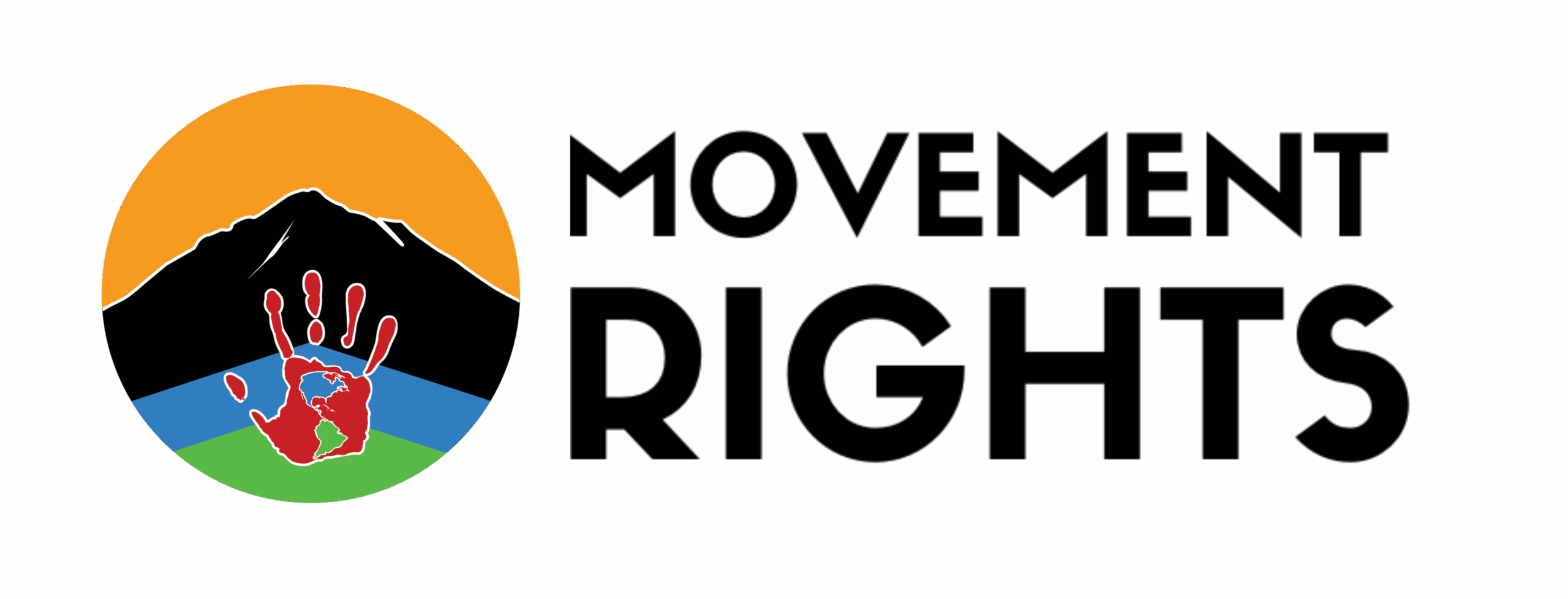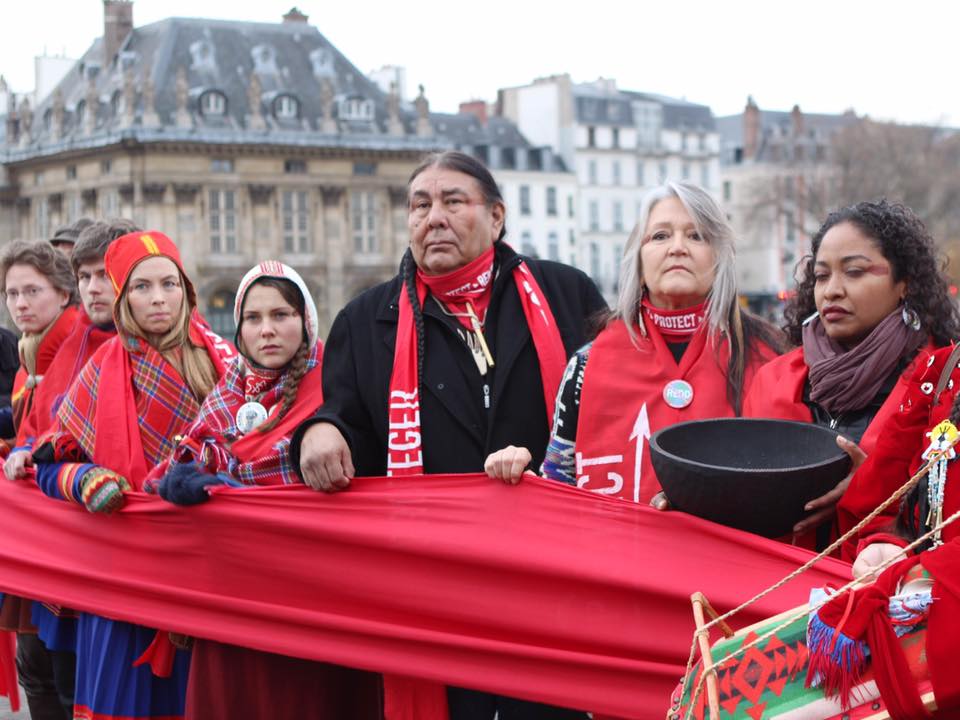By Shannon Biggs with Pennie Opal Plant
Movement Rights co-founders Shannon Biggs and Pennie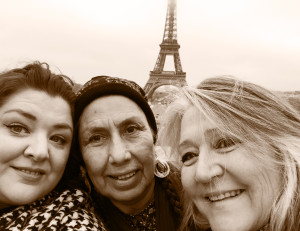 Opal Plant were in Paris for the COP 21 climate events, and to promote grassroots alternatives to the current UN process including co-producing a report on Rights of Nature, co- hosting a beyond-capacity Rights of Nature tribunal that turned away over 1,000 people, co-leading a ceremony for the signing of an international Indigenous Women’s Treaty for Mother Earth, among many other actions, interventions and activities, very often led by our board member, Indigenous leader and Ponca elder, Casey Camp Horinek (pictured).
Opal Plant were in Paris for the COP 21 climate events, and to promote grassroots alternatives to the current UN process including co-producing a report on Rights of Nature, co- hosting a beyond-capacity Rights of Nature tribunal that turned away over 1,000 people, co-leading a ceremony for the signing of an international Indigenous Women’s Treaty for Mother Earth, among many other actions, interventions and activities, very often led by our board member, Indigenous leader and Ponca elder, Casey Camp Horinek (pictured).
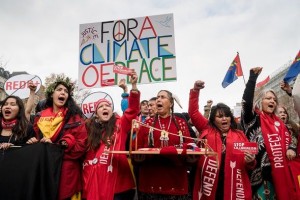
If you’ve been confused by the conflicting reports of the success COP 21 negotiations, you’re not alone. On the final day of the UN climate talks, President Obama issued a statement boasting words the nation, the ministers from 196 negotiating countries and the world wanted to hear: “We met the moment. We came together around a strong agreement the world needed.” The mainstream media quickly heralded the final agreement as ‘The world’s Greatest Diplomatic Success,’ and “Big Green” environmental groups like the Sierra Club, Avaaz and others blogged that while it may not be the war, as far as the battle, “WE WON.”
Reports of victory (or the whiff of a qualified victory) quickly flooded the internet. Yet standing on the streets of Paris on December 12—lined with over 10,000 people carrying red tulips and unfurling giant red ribbons defying the ban on demonstrations and condemning world leaders’ failure to put forward a meaningful, binding agreement—we puzzled. Were we at the same summit? From the red line action on the outside, many justice activists, economists, experts, NGO participants and Indigenous leaders had a very different take on the outcome. Former Bolivian climate negotiator, Pablo Solon told Democracy Now! “The Paris Agreement Will See the Planet Burn.” That is if it is ever even implemented.
So what does the Paris Agreement say that is creating the division of opinions?
A Quick Guide to the Paris Agreement
- The simply titled “Paris Agreement” isn’t legally binding. It’s not a treaty, but a goal for the climate future for the next 20 years, replacing 1997’s “Kyoto Protocol”. Nearly 20 years ago the Kyoto protocol was considered a historic treaty binding nations to reduce greenhouse gasses (which, despite a handful of countries’ solid efforts, have increased globally 35% since 1997). President Obama has pledged to reduce 26-28% of emissions from 2005 levels (even if this were enough, the next president could undo, change or ignore these goals). Meanwhile, the World Trade Organization (WTO) ministerial was held days after COP21. As trade expert Deborah James points out, the WTO and Trans Pacific Partnership (TPP) agreements are not only binding, they stand in sharp contrast to the Paris Agreement.
- The Paris Agreement promises to hold global average temperatures below 2° Celsius (3.6° Fahrenheit) from pre-industrial levels without a blue-print for action. Even if this goal is met, scientists warn it is already a “prescription for disaster,” But meeting this goal—while not impossible—is unrealistic given where we are and our continued reliance on fossil fuels. Current emissions are on track to reach a 4° rise by 2100, and without a radical plan for immediate change, 2° may be impossible to achieve. Add to this the Paris Agreement says absolutely nothing about how countries can or will work to reach this target over the next 20 years.
- Bad Math: Country Commitments add up to a 3° rise in temperature. As reported in CounterPunch: “The Intended Nationally Determined Contributions in Paris (which, under U.S. pressure, cannot be enforced through treaty language) will lead to a 3 degree planet by 2050 if not sooner.”
- To reach 2° we must leave 80% of fossil fuels in the ground—yet the Paris Agreement lacks a plan or the current or future political will to do it. “It’s just bullshit for them to say: ‘We’ll have a 2C warming target and then try to do a little better every five years,’”
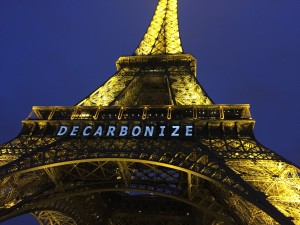
Photo: Shannon Biggs leading climate scientist James Hansen told the Guardian, adding:
“It’s just worthless words. There is no action, just promises. As long as fossil fuels appear to be the cheapest fuels out there, they will be continued to be burned.”
No country promised to “keep it in the ground”, rather the agreement seeks to “check in” on progress every five years. A good analysis of all of this can be found from 538 Science.
- The Paris Agreement reinforces the false solutions of carbon markets and the financialization of nature. This agreement is in favor of carbon trading schemes that continue to allow polluters
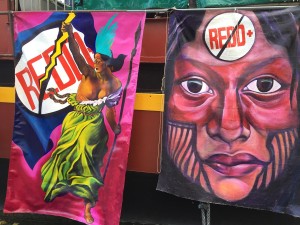 to pollute by purchasing carbon credits in other parts of the world. And, in violation of the rights of Indigenous Peoples (who are now only briefly mentioned in the preamble of the agreement), it promotes REDD and REDD+. These are carbon trading schemes which permit indigenous peoples to be evicted from the forests they have been caretaking for thousands of years. This climate agreement is being called a trade agreement by some because it continues to support the “endless more” system that has brought us to the brink of catastrophic climate change. As Movement Rights’ Shannon Biggs and IEN’s Tom Goldtooth state in a new Paris report:
to pollute by purchasing carbon credits in other parts of the world. And, in violation of the rights of Indigenous Peoples (who are now only briefly mentioned in the preamble of the agreement), it promotes REDD and REDD+. These are carbon trading schemes which permit indigenous peoples to be evicted from the forests they have been caretaking for thousands of years. This climate agreement is being called a trade agreement by some because it continues to support the “endless more” system that has brought us to the brink of catastrophic climate change. As Movement Rights’ Shannon Biggs and IEN’s Tom Goldtooth state in a new Paris report:
“The climate Ponzi scheme of trading of air, water, trees, soil, and biodiversity along with false solutions of carbon capture, genetically modified organisms, geoengineering, synthetic biology, nanotechnology, agrofuels, fracking, nuclear projects and energy generation from incineration—all these will do more harm than good to Mother Earth.” Yet this is the basis for the Paris Agreement.
- Indigenous Rights have been removed from the acting text of the agreement. Indigenous and forest peoples hold legal entitlement to 1/8 of the world’s forests, and protect about 80% of the world’s biodiversity. These are front-line communities that are the defenders of the Earth, and the stabilizers of the climate.
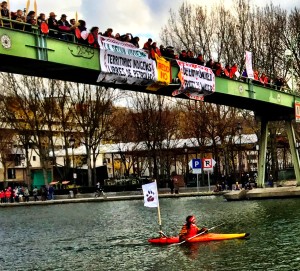
Indigenous Peoples flank the bridge standing for their rights in a canoe action in Paris, one of many indigenous-led actions. (Photo: Shannon Biggs) Recent studies show that ensuring rights for these communities would avert billions of tons of C02 emissions annually. As Tom Goldtooth, executive director of the Indigenous Environmental Network and co-editor of the Rights of Nature report said in Paris “We, Indigenous Peoples, are the red line. We have drawn that line with our bodies against the privatization of nature, to dirty fossil fuels and to climate change. We are the defenders of the world’s most biologically and culturally diverse regions. We will protect our sacred lands.”
It is abundantly clear that the countries most responsible for climate change are those which have continued to derail the climate talks over the 21 years that the United Nations Conference of the Parties has gathered. This includes the United States which is at the top of the list of countries that have historically emitted the most greenhouse gasses and continues to be a leading emitter.
Once again, these UN Climate Talks have failed the sacred system of life, preferring to support the capitalist system that is destroying our ability to exist.
Transparency? Unfortunately, no.
As in the past, climate negotiators met behind closed doors at COP 21 in Paris, not allowing civil society members to be in the room, and many deals are made in even more secret rooms between just a handful of countries, and then presented to the delegates.
So who is celebrating and why?
The standing ovation for a flimsy agreement from the delegates “inside” is easy to understand. Certainly the corporate sponsorship of the negotiations themselves speak volumes. As Cindy Weisner of Grassroots Global Justice Alliance told Common Dreams before the COP:
“[the] announcement of the corporate sponsors of the COP21 exposes the deep contradiction in UN COP process and their cozy relationship with the very corporations who are driving the climate crisis.
“The effort of these corporations to green-wash their ongoing damage of the planet in order increase profit and gain public support is offensive.” The willingness of the mainstream media to embrace a false victory is easy to understand in two words “corporate ownership”.
And as for the mixed reactions from the environmental/climate movement? Paris revealed the divide that exists between groups that consider themselves part of the environmental or climate justice movements, and the larger and less radical environmental groups. The Big Greens find that the national targets provide something to push against when everyone goes home, a way to hold politicians’ feet to the fire. There was some pressure for smaller groups to support the agreement as at least a toe-hold for change, or risk being marginalized as unreasonable. But justice-based groups either are—or see themselves are directly responsible to—front-line communities, indigenous peoples and the rights of Mother Earth.

For those of us who count ourselves in the latter category, there is no happy compromise if it comes at the expense of land defenders, so-deemed “sacrifice communities” and the resilience of the Earth that nurtures us. In this fine print of this agreement we see the fearful faces and uncertain futures of people we know, people whom we have pledged to stand to defend. There can be no celebration as world leaders promise to slow the rate of destruction, while recommitting to a path that ensures the destruction of their ways of life and future generations.
So what can we celebrate? The rise of the rights and justice movements.
While climate negotiators were meeting behind closed doors tens of thousands of people gathered in the streets to show that climate action will emerge from the grassroots. Targets won’t be “parts-per-billion” but closer to home at the source—at polluting factories, GMO crops, oil trains, fracking and other places where carbon and methane are emitted. There were at least two tribunals: The International Rights of Nature Tribunal and the Tribunal on “The People vs. Exxon Mobile.” There were prayer ceremonies, a canoe action with Indigenous people speaking out for the water, two separate official events for Indigenous women to sign the Indigenous Women of the Americas Defending Mother Earth Treaty Compact, daily direct actions and meetings of Indigenous people from around the world.
of people gathered in the streets to show that climate action will emerge from the grassroots. Targets won’t be “parts-per-billion” but closer to home at the source—at polluting factories, GMO crops, oil trains, fracking and other places where carbon and methane are emitted. There were at least two tribunals: The International Rights of Nature Tribunal and the Tribunal on “The People vs. Exxon Mobile.” There were prayer ceremonies, a canoe action with Indigenous people speaking out for the water, two separate official events for Indigenous women to sign the Indigenous Women of the Americas Defending Mother Earth Treaty Compact, daily direct actions and meetings of Indigenous people from around the world.
There was moving testimony by many Indigenous people during the Rights of Mother Earth Tribunal, which began with Movement Right’s board member, Ponca elder, Casey Camp-Horinek. She opened the Tribunal with this statement: 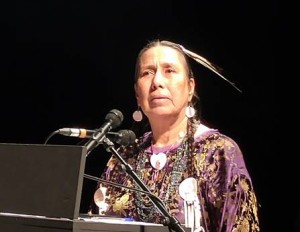
“What we have forgotten is to give back…we think that exchanging money or paying the bill with a plastic card somehow makes us even in this exchange.”
“But here today, we’re going to exchange the knowledge from both the natural world way, from the viewpoint of the Indigenous Peoples, from the viewpoint of the scientists, from the viewpoint of the law makers, from your heart, from your spirit to those spirits around you. We‘re going to share the knowledge of ‘rights of nature’ And, you should know. Aren’t you part of her?”
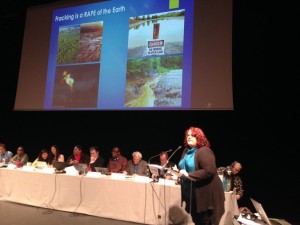
Shannon Biggs facilitated the case of fracking around the world at the Rights of Nature Tribunal, introducing front-line community experts including Kandi Mossett, an indigenous environmental activist and member of the tribal-nation community of Fort Berthold Three Affiliated Tribes of Mandan, Hidatsa, Arikara in North Dakota. Casey Camp-Horinek was also a witness, testifying about the pain that “fracturing the skeleton of Mother Earth” is causing in her community in which an average of one person a week is dying from the results of fracking and other fossil fuel related crimes. The tribunal included over 80 voices from around the world and was for many, an important highlight and a way forward for a new Earth jurisprudence and culture for living in balance with the earth. Over 1,000 people were turned away at the door of the tribunal which was also live streamed.
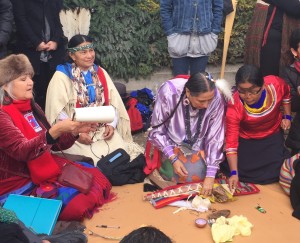
There was much excitement about the Indigenous Women of the Americas – Defending Mother Earth Treaty Compact. This Treaty calls on all who support it to conduct direct actions at the places where decision makers are allowing the harms to occur, as well as the locations where the harms are occurring. There was a formal Indigenous ceremony that took place on December 6th with many Indigenous women from the Americas signing the treaty and many non-Indigenous women signing as witnesses. There was a less formal treaty signing later in the week. Pennie Opal Plant gave a briefing about the Treaty while speaking on the WECAN panel.
What must we do to ensure a safe and healthy future? It is obvious that those who should be protecting us have failed. It is up to us to decide what happens where we live and what happens upstream from our water source. We must support the rights of indigenous peoples, communities and ecosystems. We must insist on our power as communities to declare that we are taking the decision making authority back regardless of who says we can’t. We must rise up collectively to support one another and to join together as often as possible to ensure a safe and healthy world for ourselves, future generations and our non-human relatives who have no voice. It is, truly, up to us to save the world.
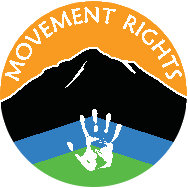 Movement Rights assists communities confronted by harmful corporate projects to assert their right to make important decisions that impact them by passing new laws that place the rights of residents (and nature) above the claimed legal “rights” of corporations. At the heart of our work is the belief that asserting our right to create the kind of place we want to live and reining in corporate power is the next evolution of the civil rights movement. Over 160 communities across the United States have already asserted their right to local self-government and stopped unwanted harms.
Movement Rights assists communities confronted by harmful corporate projects to assert their right to make important decisions that impact them by passing new laws that place the rights of residents (and nature) above the claimed legal “rights” of corporations. At the heart of our work is the belief that asserting our right to create the kind of place we want to live and reining in corporate power is the next evolution of the civil rights movement. Over 160 communities across the United States have already asserted their right to local self-government and stopped unwanted harms.
Movement Rights is a fiscally sponsored project of the Oakland Institute. We are supported by individual donations and small foundation grants. Please consider supporting our work and joining our list serve to keep up to date on the movement for rights-based change. Thank you!
